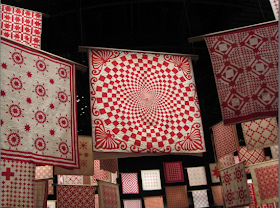On March 30, Jay and I drove down to the Park Avenue Armory, in Manhattan, to view "Infinite Variety," a special quilt event coordinated by the American Folk Art Museum. This six-day-only installation featured 651 red-and-white quilts from the collection of Joanna S. Rose. It was worth the drive; indeed Jay compared it to Christo's 2005 "The Gates" project as a spectacle not to be missed. This was even better, though, as the quilts were comfortably indoors, and, instead of endlessly repeated orange banners, each and every quilt was an individual creation. As one online commenter said in a post at the New York Times website, it was like being hugged by 651 women at once, http://cityroom.blogs.nytimes.com/2011/03/24/finally-mrs-rose-and-the-public-can-see-all-her-rugs/

 Exhibit banner outside the Armory.
Exhibit banner outside the Armory.

Thinc [sic] Design, which master-minded the installation, deserves kudos for the dynamic way in which the quilts inhabit the cavernous Armory drill hall. A unique free-span space, the hall is reminiscent of a state fairgrounds barn, but right in Manhattan. Learn more about the Armory's history, and current programming, at http://www.armoryonpark.org/index.php/
The quilts were hung in circular groups called pavilions, which enclosed the viewers, creating an immersive experience.
The quilts were hung in circular groups called pavilions, which enclosed the viewers, creating an immersive experience.
 Visitors silhouetted in front of quilts.
Visitors silhouetted in front of quilts. Their strong graphic quality allows quilts to be "read" even from a distance,
Their strong graphic quality allows quilts to be "read" even from a distance,allowing a vertical presentation.
 Quilts rising up.
Quilts rising up.By limiting herself to red-and-white quilts for this exhibit, Mrs. Rose created a group show whose impact is greater than the sum of its parts. By holding color constant, the variability of pattern became that much more powerful.
Many traditional quilt patterns are represented - Drunkard's Path, Burgoyne Surrounded, Schoolhouse, just to name a few - but also quilts of idiosyncratic design and execution. Even the classic pattern quilts display much individuality in borders and bindings. Additionally, the quilting - mostly by hand - shows up beautifully on the solid fabrics.
We were at the installation on the last day, which was packed with viewers in every age, shape, size and degree of mobility, with men well-represented, a bit unusual for a quilt show.
Technology assisted with audio descriptions of select quilts accessed by cell phone; viewers could also borrow iPads with special apps. A cafe and the inevitable gift shop made the experience complete. We stayed until the exhibit closed at 5 pm, just savoring the presence of so many quilts and the spirits of their makers.











